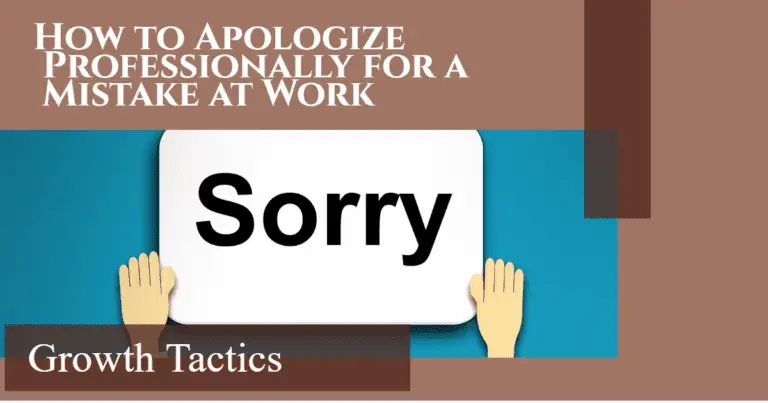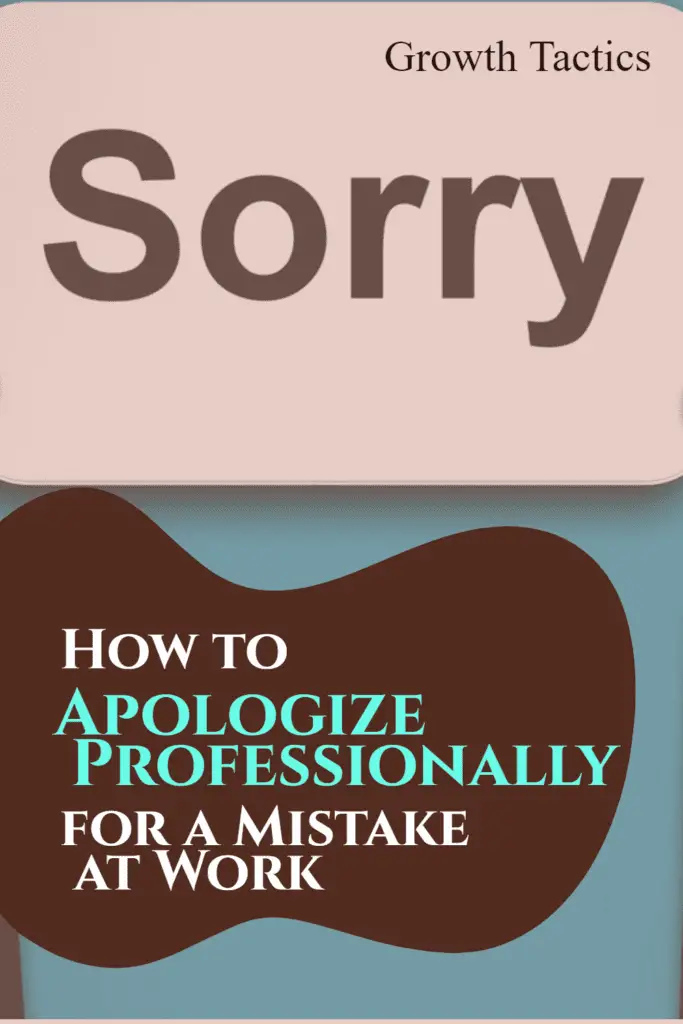We’ve all been there – making a mistake at work can happen to anyone. It’s not the end of the world, but it’s essential to handle it professionally. In this article, I’ll guide you through the process of apologizing for a mistake at work, offering valuable tips on how to apologize professionally, take responsibility, and restore trust in your professional relationships. So, let’s dive in and learn how to turn a mistake into an opportunity for growth!
Jump To Section
Acknowledge Your Mistake
It’s time to shine a light on the first step to apologizing professionally: acknowledging your mistake. Let’s face it, we’re all human, and we all make errors occasionally. It’s entirely okay! The key is to embrace the fact that perfection is an elusive concept, and slip-ups are a natural part of life.
Showcasing self-awareness is crucial. By recognizing and accepting your mistake, you reveal your ability to confront the situation head-on. This valuable trait demonstrates integrity and a commitment to personal growth.
Remember, making a mistake doesn’t define you as a person or a professional. It’s how you handle it that truly matters. So take a deep breath, dust yourself off, and let’s move forward with grace and resilience.
Take Responsibility and Apologize
Now that you’ve acknowledged your mistake, it’s time to move to the next step – taking responsibility. This step requires a dose of courage, humility, and honesty.
Taking responsibility means recognizing that your actions had consequences and acknowledging the impact they had on others. It’s about setting aside excuses and any inclination to shift blame. Taking ownership shows maturity and a genuine desire to make things right.
By taking responsibility, you validate the trust placed in you and demonstrate your commitment to rectifying the situation. It’s a step towards rebuilding any damaged professional relationships and cultivating a positive work environment.
Apologize Professionally at Work
Now that you’ve acknowledged your mistake and taken responsibility, it’s time to offer a heartfelt apology. Remember, a professional apology is more than just saying the words; it’s about conveying sincerity and authenticity.
When apologizing, it’s essential to express genuine remorse. Let your words reflect your understanding of the impact your mistake had on others. Be careful not to make excuses or downplay the situation. Instead, focus on your intention to make amends and learn from the experience.
Expressing your regret and apologizing sincerely shows that you value the trust and relationships you have built in the workplace. It demonstrates your professionalism, authenticity, and your commitment to personal and professional growth.
Maintaining a Positive Work Environment
Creating a positive work environment is essential for productivity and healthy professional relationships. When you apologize professionally, you contribute to the overall well-being of the workplace. By handling mistakes with grace and sincerity, you foster trust and encourage open communication among your colleagues.
The Importance of Sincerity
When apologizing, it’s vital to convey sincerity in your words and actions. People can sense insincerity from a mile away, and a half-hearted apology can do more harm than good. Take time to reflect on your mistake and genuinely express your remorse. This will help rebuild trust and strengthen your professional relationships.
The Need for a Short and Sweet Apology Email:
When time is of the essence and a face-to-face apology may not be suitable, an apology email is a practical solution. It allows you to promptly address the issue while demonstrating professionalism and the sincerity of your apology.
Crafting Your Apology Email
To ensure your apology email hits the mark, follow these simple steps:
-
Be to the point: Start your email by clearly stating the purpose – to apologize for your mistake. Get straight to the point, ensuring that the recipient understands your motive from the very beginning.
-
Acknowledge the mistake: Briefly describe the mistake you made, acknowledging the impact it had on others. Be concise, but ensure you convey the gravity of the situation. This shows that you understand the implications of your actions.
-
Express sincere regret: Highlight your genuine remorse in a heartfelt manner. Emphasize your understanding of how your mistake affected others, and use words that demonstrate your sincerity and empathy. This helps create a connection and lets the recipient know that you truly regret your actions.
-
Take responsibility: Accept full responsibility for your mistake. Avoid making excuses or shifting blame onto others. This showcases your professionalism and integrity, as you demonstrate accountability for your actions.
-
Offer a solution (if applicable): If appropriate, include a plan of action to rectify the situation or prevent a similar mistake in the future. This demonstrates your commitment to growth and improvement. However, be mindful not to make promises you can’t keep.
-
Close on a positive note: End your email on a positive and optimistic tone. Express gratitude for their understanding and patience, and reiterate your regret for the mistake. This helps leave a lasting impression of goodwill.
Remember, brevity is key when crafting a short and sweet apology email. Be mindful of the recipient’s time and keep your message concise and focused.
Proofread and Send
Before you hit that ‘send’ button, take a moment to proofread your email. Check for any grammatical errors, typos, or unclear wording. A polished and error-free email shows professionalism and attention to detail.
Once you’re satisfied with your email, send it promptly. The sooner you address the mistake, the better. Promptness demonstrates your eagerness to make things right and preserves trust in your professional relationships.
Additional Tips for Apologizing Professionally at Work
These additional pointers will help you navigate the delicate process of apologizing professionally with finesse and confidence. So let’s dive right into these handy tips and make sure your apologies are top-notch!
Communicate with empathy and active listening:
To truly connect with the person you’re apologizing to, it’s important to communicate with empathy. Put yourself in their shoes and imagine how they must have felt when the mistake occurred. Show genuine understanding and compassion.
Active listening plays a crucial role too. Listen attentively to their perspective and allow them to express their feelings. It can provide valuable insights into their experience and show that you genuinely care about their concerns.
Be specific and avoid generalizations:
When offering your apology, make sure to be specific about what you’re sorry for. Generalized apologies can come across as insincere or vague. Instead, pinpoint the exact mistake or action you’re apologizing for. This specificity demonstrates accountability and shows that you have reflected on your actions.
Offer a solution or action plan for the future:
In addition to expressing regret, consider offering a solution or action plan to prevent similar mistakes from happening in the future. This proactive approach shows that you’re committed to growth and want to prevent the same error from occurring again.
For example, if you missed a deadline, explain the steps you’ll take to improve your time management or offer to set up reminders to avoid a repetition of the mistake. Showcasing your determination to learn from the experience will be highly valued.
Follow up and reaffirm your commitment:
After apologizing, it’s essential to follow up. Once some time has passed, check in with the person you apologized to, and ask if there’s anything else you can do to rectify the situation or rebuild trust.
Additionally, reaffirm your commitment to maintaining a positive and respectful professional relationship. Let them know that you value their trust and that you’re eager to restore it fully.
Conclusion
In the world of work, making mistakes is an inevitable part of life. It’s how we handle those mistakes that define our character and professionalism. Remember, a genuine apology shows strength and maturity. By acknowledging your errors, taking responsibility, and apologizing professionally, you can rectify the situation, maintain a positive work environment, and strengthen your professional relationships. So, embrace the opportunity for growth, apologize sincerely, and let your actions speak louder than words.


